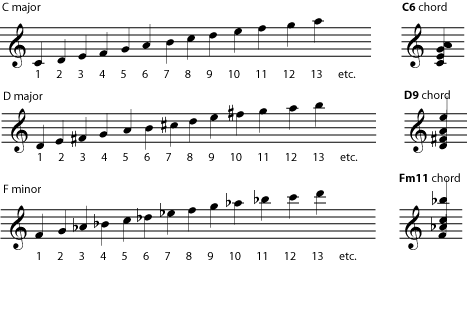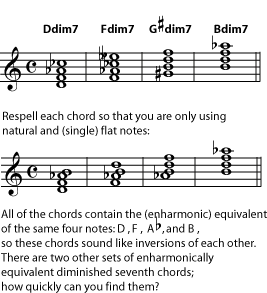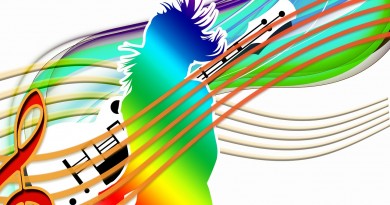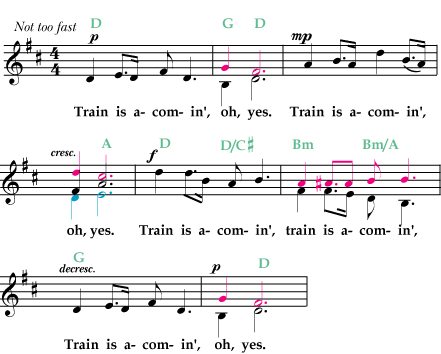Naming Seventh Chords and Harmonic Practice – Music Theory
The name of a chord is determined by the relationships of all the notes in the chord to the tonic.
Once you know how to name triads (please see Triads and Naming Triads), you need only a few more rules to be able to name all of the most common chords. This skill is necessary for those studying music theory. But it’s also very useful at a “practical” level for composers, arrangers, and performers (especially people playing chords, like pianists and guitarists), who need to be able to talk to each other about the chords that they are reading, writing, and playing.
Chord charts, manuals, fingering charts, and notes written out on a staff are all very useful, especially if the composer wants a very particular sound on a chord. But all you really need to know are the name of the chord, your scales, and a few rules, and you can figure the chord out for yourself.
Music chords : triads and seventh
What do you need to know to be able to name most chords? You must know your major, minor, augmented and diminished chords. Either have them all memorized, or be able to figure them out following the rules for triads. (Please see Triads and Naming Triads.)
You must be able to find intervals from the root of the chord. One way to do this is by using the rules for intervals (please see Interval). OR if you know your scales and don’t want to learn about intervals, you can use the method in #3 instead. If you know all your scales (always a good thing to know, for so many reasons), you can find all the intervals from the root using scales. For example, the “4” in Csus4 is the 4th note in a C (major or minor) scale, and the “minor 7th” in Dm7 is the 7th note in a D minor scale. If you would prefer this method, but need to brush up on your scales, please see Major Keys and Scales and Minor Keys and Scales. You need to know the rules for the common seventh chords, for other added notes, and for bass notes. The basic rules for these are all found below.
Seventh Chords
If you take a basic triad and add a note that is a seventh above the root, you have a seventh chord. There are several different types of seventh chords, depending on what type of triad and what type of seventh is used. Here are the most common.
Seventh (or “dominant seventh”) = Major triad + minor seventh Major Seventh = Major triad + major seventh Minor Seventh = Minor triad + minor seventh Diminished Seventh = Diminished triad + diminished seventh (half step lower than a minor seventh)
An easy way to remember where a seventh is:
The major seventh is one half step below the octave. The minor seventh is one half step below the major seventh. The diminished seventh is one half step below the minor seventh. Seventh Chords Figure 1:

The “dominant seventh” – so-called because it gives a very strong dominant, leading to the tonic feeling – is the most common seventh chord. It is usually simply
labeled with a 7, for example C7. Major sevenths, minor sevenths, and diminished sevenths each have a couple of common labels. For example, a C minor seventh may be
labeled “Cm7” or “Cmin7”.
Listen to the differences between the C seventh, C major seventh, C minor seventh, and C diminished seventh.
Added Note Chords
The seventh is not the only note you can add to a basic triad to get a new chord. You can add any note you want, but the most common added notes are notes in the scale named by the chord. For example, consider a C major scale.
Adding Notes

To find out what to call a note added to a chord, count the notes of the scale named by the chord.
The first, third, and fifth (1, 3, and 5) notes of the scale are part of the basic triad. So are any other notes in other octaves that have the same name as 1, 3, or 5. In a C major chord, for example, that would be any C naturals, E naturals, and G naturals. If you want to add a note with a different name, just list its number (its scale degree) after the name of the chord.
C Added-note Chords

Performers often get to decide exactly how to play an added-note chord. Low-number added-notes often replace one of the regular notes of the chord (4 replacing 3 for example, or 9 replacing 8). Or a performer may decide to leave in all the notes of the chord, as here in the C6 chord. When playing a high-number added-note, you can also add a seventh and/or the other high-number added-notes in between the seventh and the named added-note. In a C13, for example, you can add a 7, 9, and/or 11 too. (Here a 7 and 11 are added with the 13.)
Note: All added notes, including sevenths, introduce dissonance into the chord. In some modern music, many of these dissonances are heard as pleasant or interesting or jazzy and don’t need to be resolved. However, in other styles of music, dissonances need to be resolved, and some chords may be altered to make the dissonance sound less harsh (for example, by leaving out the 3 in a chord with a 4). You may have noticed that, once you pass the octave (8), you are repeating the scale. In other words, C2 and C9 both add a D, and C4 and C11 both add an F. While they may be technically the same, these chords in practice usually do sound different; performers given a C4 chord will put the added note near the bass note and often use it as a temporary replacement for the third (the “3”) of the chord. On the other hand, they will put the added note of a C11 at the top of the chord, far away from the bass note and piled up on top of all the other notes of the chord (including the third), which may include the 7 and 9 as well as the 11. The result is that the C11 has a more diffuse, jazzy or impressionistic sound. The C4, on the other hand, has a more intense, needs-to-be-resolved, classic suspension sound. In fact, 2, 4, and 9 chords are often
labeled suspended (sus), and follow the same rules for resolution in popular music as they do in classical. Figure 4:

Low-number added notes and high-number added notes are treated differently. So even though they both add a D, a C4 suspension will sound quite different from a C11 chord.
Bass Notes
The bass line of a piece of music is very important, and the composer/arranger often will want to specify what note should be the lowest-sounding in the chord. At the end of the chord name will be a slash followed by a note name, for example C/E. The note following the slash should be the bass note.
Naming the Bass Note Figure 5:

The note following the slash is the the bass note of the chord. It can be a note that is already in the chord – making the chord a first or second inversion – or it can be an added note, following the same basic rules as other added notes (including using it to replace other notes in the chord).
The note named as the bass note can be a note normally found in the chord – for example, C/E or C/G – or it can be an added note – for example C/B or C/A. If the bass note is not named, you will probably use the tonic as your primary bass note.
Practice on chords






